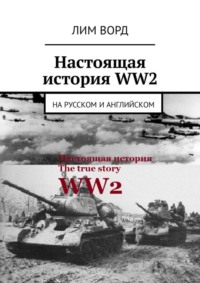
Настоящая история WW2. На русском и английском

Настоящая история WW2
На русском и английском
Лим Ворд
© Лим Ворд, 2018
ISBN 978-5-4493-1216-7
Создано в интеллектуальной издательской системе Ridero
In the design of the cover of the book the symbols of the Allied victory are used – the American B-29 bomber and the Soviet T-34-85 tank
При оформлении обложки использованы символы победы союзников – американский бомбардировщик В-29 и советский танк Т-34-85
The book is based on many sources, confirming the reliability of each other. In this text there are no discoveries and sensations, but for the first time a coherent and consistent presentation of the epoch is presented.
The author is not tied to the interests of political parties, organizations, social strata, and therefore has the right to declare his perfect impartiality.
A common vision of history is what is important for establishing public consensus. Going outside the Federation, you can take a printed book to build on the text, explain to partners, or friendly English-speaking opponents, how everything was in fact.
Regrets and apologies for the automatic, though fairly high-quality, corrected translation.
Книга основана на комплексе независимых источников, подтверждающих достоверность друг друга. В данном тексте нет открытий и сенсаций, но впервые представлено связное и непротиворечивое изложение эпохи.
Автор не завязан на интересы каких-либо политических партий, организаций, социальных слоев, и потому вправе заявить о своей совершенной беспристрастности.
Общее видение истории – то, что очень важно для установления общественного согласия. Отправляясь за пределы Российской Федерации вы можете взять отпечатанную книгу, чтобы опираясь на текст, объяснить партнерам, или дружелюбным англоязычным оппонентам, как все было на самом деле.
Сожаления и извинения за автоматический, хотя и достаточно качественный, правленый перевод.
Заказать печатную книгу вы можете, открыв ресурс «Ридеро». Там же, а также на «Литрес» доступен электронный вариант.
The Beginning
Formation of the Third Reich
The appearance of the Third Reich (empire), which he became for 13 years and 13 days, as some historians believe, is the merit of the only person – Adolf Hitler (Hydler). The surname is identical to the meaning «forester, caretaker». The only half-sister, Paula, the artist, lived until 1960, Angel’s half sister (by father), a housewife until 1949, her son Leo Hitler, was captured during the Battle of Stalingrad and was offered for exchange for his son Stalin, Yakov. Brother Edmund dies at a minor age.
As a child, Hitler was battered by his father, twice changed his school due to poor progress and bad behavior. The only teacher he relishes is the history teacher, who speaks the history of ancient Germany, inspiring the students with the idea of the superiority of the German people.
In 1908, Hitler failed examinations at the Vienna Academy of Arts. He does not want to engage in any kind of physical labor in principle.
Relations with women in Adolphus there are no, according to some testimonies – because of fear of infection with syphilis… or because of elementary hypertrophied shyness. The only school friend of Adolf, August Kubichek (future musician of the Vienna Conservatory) in his memoirs mentions the girl Stephanie, … a slender blond Valkyrie of 17 years. Hitler collects information about his beloved for four long years, experiences a certain lieutenant because of her enthusiasm, writes countless poems, such as «The Hymn of the Beloved», etc. However, despite the fact that A.G. there are certain chances (once, at the celebration of the flowers of Stephanie, with a smile throws the best flower in Hitler), Adolf considers himself above some kind of flirting. The lack of words and actions, only timid, even fanatical views – this is not exactly what the girls want.
The financial side of life sags with time. The future leader of the Third Reich stays on the streets, digs in garbage cans, in search of food, begs…
Since 1909, the sale of painted postcards with views of Vienna begins to bring Adolf a good income. Relations with women are getting better.
A.G. studies English and French in the amount sufficient to view the films of these countries in the original, is actively interested in arming the armies of the world and politics. He does not want to serve in the Austrian army «for the Czechs and Hungarians», but in 1914, with the beginning of the Great War, he makes an application with a request to serve in the Bavarian (German) army. In 1918, Hitler was poisoned by the gas of a chemical shell exploding nearby the English. Half lost sight, he leads the blind comrades from the firing zone. It was at this time, according to his testimony, along with the news of the surrender of Germany, that he found a revelation about the revival of the Reich and miraculously healed. According to mythology, possibly having real roots, Hitler (1) receives a suggestion from a doctor, a powerful hypnotist, that he is the Messiah of the German people, and, therefore, must see through. Or, (2) Concludes an agreement with a representative of the dark forces that he will be given power for 13 years and 13 days (January 30, 1933 – April 30, 1945) for the rise of the German nation.
In November 1923, the rate of the German mark is 4.2 trillion for the American dollar. In 1924, parallel to it, the unofficial monetary unit – the so-called. rental mark secured by a pledge of immovable property. The rate to the ordinary mark is one to one trillion. A few months later, a legitimate Reichsmark (RM) appears, equal to it at face value, and both these currencies remain in circulation in order not to undermine public confidence. The cost of one RM – 2.5 grams of pure silver, which at the current rate is about 150 rubles. The appearance of these denominations suspends hyperinflation (5000%, the issuance of wages – twice a day, people are starving).
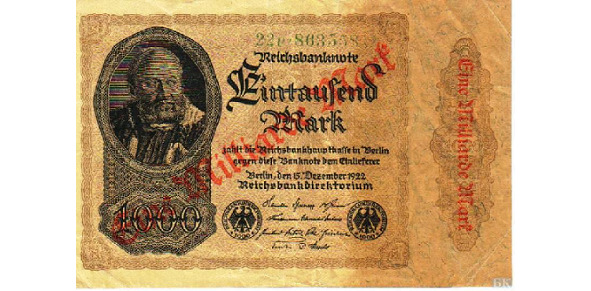
1. Billion of German marks in 1923
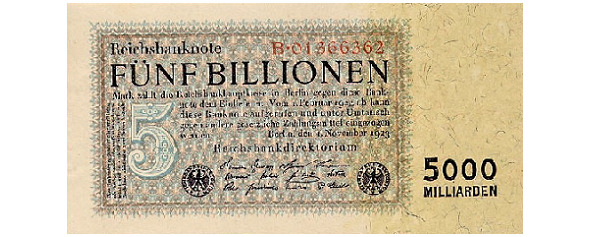
2. Five trillion paipermarks of the same year 1923…
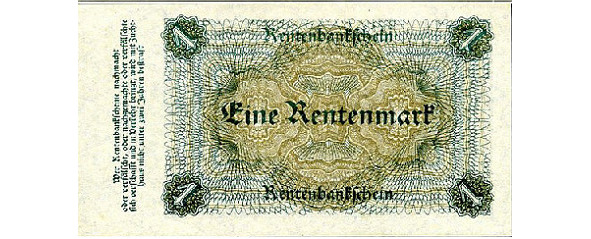
3. Rental stamp
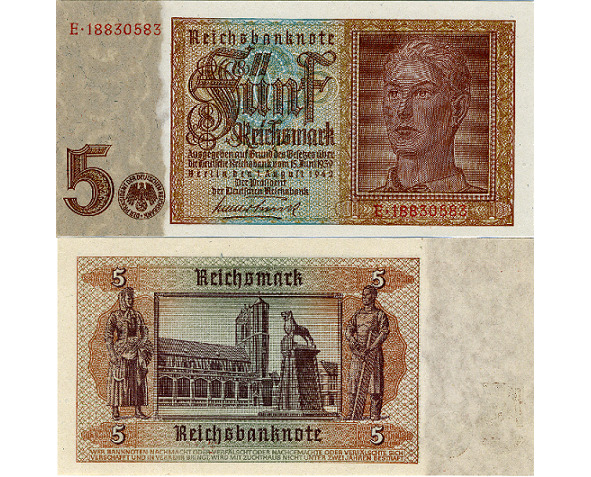
4. Reichsmark of 1942 issue
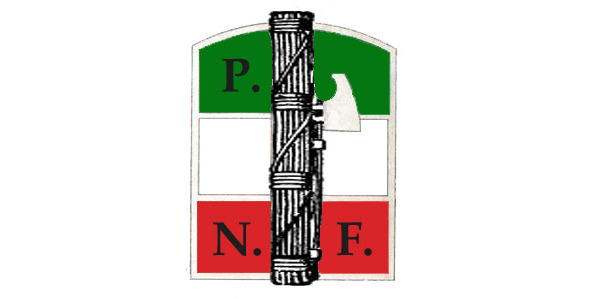
5. The emblem of the Italian (primordial) fascism
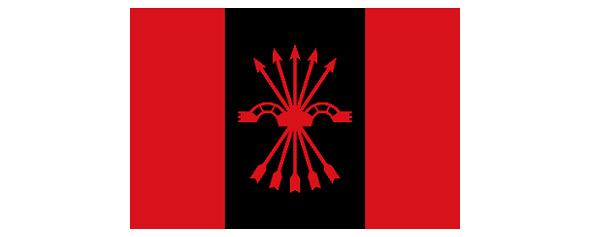
6. Emblem of the Spanish fascists

7. The emblem of the nationalist «Iron Guard» of Romania

8. Symbol of the Polish Phalanx
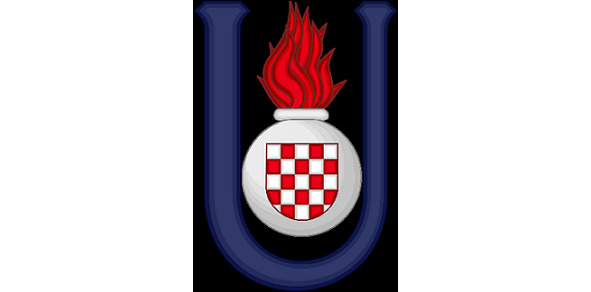
9. The symbol of the Croatian «Ustashi»

10. Flag of the National Socialist Party of Hungary «Crossed arrows»
1. Billion of German marks in 1923. Till this time, Germany was called the Weimar Republic. Somehow it turned out that the division of the country could be contained, providing hyperinflation (the Rhineland was preparing to secede). Prices doubled every three days, in circulation was the so-called paper stamp (Papiermark). A beer mug cost four billion. In 1924, inflation was stopped. By the mid-twenties, the republic had achieved certain economic and political successes, but since 1929 a new, though not so strong, recession had followed. In the end, the Germans decided that the way out of the situation was in the new leaders and the Third Reich.
2. Five trillion «paper» brands in 1923.
3. Rental stamp. Provided with industrial potential, real estate, very popular. The rate is one to a trillion of «pipermaroks».
4. Completely solid in design and execution of the Reichsmark of 1942 issue. A severe aesthetics of the new state order is visible. The salary of a German lieutenant (Obersturmfuhrer) is 220 marks a month. The purchasing power of the brand in the main set of products and services is about the same as that of the modern 7.5 dollars. The course towards the American currency, strangely enough, remained stable, until 1945.
5. The emblem of the Italian (primordial) fascism is a bundle of fascias (Latin fasces- rods), birch or elm rods, rods tied with a red ribbon, with a hatchet in them. This symbolism in Russia is not prohibited, it is used by such state entities as the Federal Penitentiary Service and the Federal Bailiff Service.
6. Emblem of the Spanish fascists, otherwise – of the Franco, Falangist, the party Falange Española. Arrows and yokes are symbols of the unifiers of Spain, the Catholic monarchs Isabella of the First Castilian and Ferdinand of the Second of Aragon. This form of fascism exists even after the end of World War II, until 1975 – the time of the natural death of dictator Franco Franco.
7. Lattice – a symbol of suffering for freedom, the emblem of the nationalist «Iron Guard» of Romania.
8. Symbol of the Polish Phalanx. The Poles are ardent nationalists, they do not recognize kinship with the Slavs, they are looking for their heroic forerunners in the semi-mythical tribe of the Sarmatians or even the Germanic tribes. Be that as it may, at the beginning of the Second World War, one nationalism almost completely destroys another, and this circumstance undoubtedly helps the Allies to win.
9. The symbol of the Croatian «Ustashi» (Horst «Ustaše» – «TheInsurrection»). The main idea of those who consider themselves descended is a mono-national state, anti-Semitism, serbophobia, nationalism, territorial claims to Serbia. Under the Germans, the Ustash, along with some Bosnian Muslims, form the Waffen SS corps, numbering about 113,000, physically destroying 400,000 Serbs, Jews and Gypsies.
The postwar policy of Yugoslav leader Josip Broz Tito – «Forgetting everything bad» only leads to the fact that in the early 1990s, non-repentant Croatian nationalists go on relapse, and unleash a bloody Civil War.
10. Flag of the National Socialist Party of Hungary «Crossed arrows». In fact, the «Crossed Arrows» and its sole leader, Ferenc Salashi rule parallel to the government of Miklos Horthy. It is Horthy who initiates the entry of his state into the Second World War. The main goal, at the very beginning of the expansion, is the return of considerable territories, more than half of the country lost by Hungary under the Versailles Treaty. Further, the non-fascist formally Hungary, whether or not, is forced to participate in all military operations of Hitler’s Germany.
In October 1944, the Horthy government announced a truce with the USSR. A detachment of saboteurs Otto Skorzeni kidnaps Horty’s son. Under such pressure, the head of state transfers powers to Ferenc Salashi, and moves away from business.
The «Crossed Arrows» party rules until March 1945.
The way to power was determined after Hitler was sent to the army propaganda courses: his speeches were noticed by influential people. Fourteen years later, A.G. becomes simultaneously Reichspresident and Reichskanzlerom; These long names are shortened to the word «Fuhrer» – «leader.»
The first speeches of Hitler in this post are reduced to defining the world as an unconditional value, however, one way or another, its achievement follows from the return of lands lost by Germany after the Great War.
Landmark of the German Fuhrer – the movement of «blackshirts» in Italy. Since 1919, this southern country is experiencing a «red two-year». The workers organize election committees on the direct model of the Soviets in Red Russia, seize enterprises, and try to control them more or less efficiently. The example of the USSR that is formed in general, does not bring inspiration to the Italian proletariat: this is a civil war, the physical annihilation of classes, mutual embitterment, power structures that seem to be completely out of control, apparently to no one at all. The red two-year period is replaced by the second anniversary of black. In October 1921 the squadrist, a voluntary national security militia, in the number of about 5,000 people, organize a march to Rome. King of Italy Victor Emmanuel meets with the head of the fascists Benito Mussolini, confirms him as prime minister.
The main idea of the Mussolini duce is a corporate state, the unification of classes on the basis of a common nationality and awareness of the exclusivity of their state. Introduced in particular, the laws on the inadmissibility of mixed marriages of Italians with non-Europoid races. The dialectic of fascism rejects peace, tranquility as some absolute value, recognizes war, and other perturbations are an indispensable means of improving mankind.
In general, Italian fascism is much milder than Hitler’s National Socialism. Whatever it was, the corporate state gives its citizens stability, work, a piece of bread and some enthusiasm. It successfully fights with, it would seem, a national brand, and the disaster of Italy – the mafia. However, the payment for such a way of uniting the masses, albeit with some delay – participation in many bloody battles of the Axis bloc in the South and East.
The ideology of fascism, to a greater or lesser degree, takes possession of many European states: Spain, France, Hungary, Austria, Romania, Croatia, Portugal, etc. In Japan, since 1938, in fact, the plan of «Great East Asia "– free from European influence, but under the direct control of the Land of the Rising Sun zone; which includes, among many other things, the whole of China. Militarism is not quite fascism, since it is not tied to a single charismatic dictator. This structure implies controlled tension in society, the creation of an image of an insidious external enemy, overstated by the military economy (albeit at the expense of the most important social programs), extensive external expansion.
The main idea of Hitler is the «People’s State», uniting all the Germans, regardless of the degree of their prosperity and titles, and also the notorious «Tough Vertical of Power». The national state does not at all provide for a true democracy, however, the «loophole» of opinions, a certain initiative of citizens are not punished so harshly and thoughtlessly as in the Stalinist USSR. The value of the blood of «full» Germans was initially large enough. Those Germans who somehow disagree with the policy of the NSDAP are subjected to reprisals only after several, quite intelligible cautions.
«Decisions by the majority are not provided, decisions are made only by responsible persons. Of course, every leader will have a staff of advisers at his disposal, but he will be the only one to decide… only he has the authority and the right to give orders. … It is impossible to do without the parliament, but its role is to give advice. The chambers are working bodies, not voting tools.»
Adolf Gitler.
The ideas of universal unification are inherent in Germany, first of all, since 1648, when the Westphalian world was concluded, which put an end to the terrifying Thirty Years’ War. The German world is divided into three hundred autonomous states, within each of which an unlimited dictatorship is now prescribed. Serfdom is being restored. Henceforth, the prince occupies the highest position in the local church hierarchy. Any electivity (spiritual Synod, collegium of hierarchs, flock) is absent in principle. The ruler creates only that which comes to his mind.
In other countries of Europe, the spiritual and earthly branches of the authorities are at least somewhat divided. Or else (England of the time of Henry the Eighth, the Suprematist Act of 1534, the King – the Head of the Church), the monarchy itself moves, even if in a very complicated way, towards constitutionality, and the principles of collegial decision-making. The exception, alas, is Russia, whose religious figures, since the time of the violent Baptism of 988, are getting used to compassion to the earthly authorities in every possible way.
…The church structures of Germany in the second half of the 1930s become a continuation of the state. Various terms of imprisonment are received by about 700 protestants pastors who do not agree with this state of affairs. The head of the alternative, Christian Confessionary Church, Dr. Nemmler, is taken into custody by the Gestapo in 1937, and is released by the Allied forces only in 1945.
Scientific and art are also subjected to universal unification. From now on, so little predictable currents of thought… insights, discoveries, are called to lead, as they say, «specially trained people.»
You can argue a lot about the hidden springs of a gradually unfolding unthinkable action. One of them, usually not mentioned by historians, as something insignificant, is the massive use of German troops, the population and leadership of the Reich, psychotropic substances. Tobacco smoking is not welcome, although in a combat situation this is perhaps the best way to relieve stress. In the course of «Pills of cheerfulness», pervitin (methamphetamine), the official component of the combat diet of German soldiers. The narcotic, which generates a sense of omnipotence, impunity, a psychoactive drug, is a part of food products, for example «tank chocolate» and sweets. Massively applied since 1938. The Wehrmacht receives about 12 million tablets a month from Temmler and Knoll, with a recommended dose of 2 tablets per day. According to some reports, by the time of the invasion of France, production has reached 833,000 pills per day. Hitler does not smoke tobacco, but takes pervitin from his personal physician Theodore Morrell since 1936 (actually, the beginning of expansion); since 1943 – several doses per day.
This drug, in addition, mobilizes forces, as if the body received a signal of danger – although, in fact, there can be no threat. But, subsequently, after such energy stimulation leading to numerous injuries, nerve cells die hundreds of thousands per day. It is interesting that the drug is recommended for mass consumption, like a panacea, even, for example, to treat female frigidity, and to facilitate delivery. It can not be said that the German authorities specifically promote the spread of pervitin; but they do not interfere with its spread at all.
…In 1930, Germany produces 200 tons of heroin, deploys also the production of other, cheaper, synthetic drugs. Overseas territories have been lost, according to the Versailles Treaty, however, many Latin American countries are willing to supply raw materials. Initially, aspiring to sole authority over the consciousness of its citizens, the National Socialist Party of Germany (NSDAP) strongly opposes the use of opiates. The concept is introduced: «Your own body belongs, first of all, to the family and the nation», in contrast, it seems, really decadent thesis of the Weimar Republic: «Your body belongs only to you.» However, synthetic drugs, now called «energy stimulants,» thanks, in addition to everything, to Hitler, just drop out of the list of banned drugs.
In 1929, Nuremberg created the National Socialist Union of German Doctors, which, by the end of 1933, had 11,000 participants (23% of all German medical personnel). They, based on the data of their patients, create «files of heredity archives». The main idea – the mentally retarded people do not have a right to exist – which, for the sake of humanity and prosperity of the nation, should be broken off in one way or another. Already since 1933, representatives of this union occupy leading positions, informally dispose of a gradual reduction in the standards for supplying food to patients of care and medical institutions – up to a lethal outcome.
Since October 9, 1935, almost legal, the T-4 program starts (from the name of the street Tigartentstrasse, house 4, where the headquarters of this organization was located), designed to reduce the population of Germany by the formula 1000: 10: 5: 1. Out of a thousand people, ten are disabled – five of them should be assisted, one physically eliminated. Planck rises: it now follows «To destroy all those who are unable to work productively, and not only deprived of reason.» In total, before September 1, 1941, 70,273 of its citizens were killed in German hospitals: at least 885 million marks were saved for the Army and Government. At the same time, German doctors working in the program receive monetary allowance more than anywhere else in the Reich. For each «processed dossier», that is, the death of the patient, a fee of 100 Reichsmarks is paid – plus the use of the food stamps of the deceased remaining in the course of the month before the end of the month, the issuing of bills for his relatives to his relatives, within the specified time, and, gold crowns.
Also terminally sick children are destroyed, later – adolescents under 17 years old, diagnosed with Down’s syndrome, microcephaly, hydrocephalus, all kinds of malformations, paralysis and so on. The value of each child’s life is determined in accordance with economic criteria. Parents are informed of the death of children as a result of pneumonia, or other fictitious causes. The body is cremated anyway.
In addition, about 400,000 people with an arbitrarily diagnosed diagnosis (most often «schizophrenia»), sometimes simply – the political enemies of the Reich, from 1943 to 1945, are subjected to forced sterilization.
Thus, the hospitals of the Third Reich are exempt from former hospital patients. However, some hidden laws of retaliation come into effect, medical institutions are quickly replenished by the wounded, at the front, and as a result of increasing air strikes.
Such a policy of the NSDAP ceases to please even some of its influential functionaries. In the end, a very weighty message of ferment in the minds reaches Hitler’s ears by Hannah Reich, the personal pilot of the Fuhrer. By August 1941, the T-4 program in Germany is partially curtailed, its main structures, trained medical personnel, mobile gas chambers are moving to the East. Here, killing people is done by the introduction of barbiturates, more often by an elementary «lowering» of the diet to zero. In total, on the territory of the Soviet Union (including the Baltic States), as well as in Poland, German doctors kill a million «Ostarbeiters», and an unknown number of German soldiers with severe injuries…
…In 1934, 97% of Germany’s debts to Great Britain and the United States (total 23.3 billion marks) are written off. This act is prompted by a similar decision and other countries in Europe. Switzerland agrees to sell Reich gold for the Reichsmark; later she does not disdain to accept hundreds of kilograms of gold crowns from the concentration camps.
The Civil War in Spain
After the fall of 1931, the monarchy, the new Republican government of Spain abolished aristocratic titles, greatly reduced the armed forces, and selected surplus land from the landlords (over 200 hectares). Already not popular with the majority of the population, an overly politicized and biased church, is separated from the state.
All these reforms are carried out inadequately and cause strong opposition from a significant part of society. The rebellion begins on July 17, 1936 in Spanish Morocco. July 18, he throws himself in, in fact, Spain. On the side of the putschists – 80% of the highest officers, mostly ground forces. Since July 27, the rebels are beginning to receive military and technical assistance from Germany and Spain – the bombers SM-81, Yu-52, the CV3 / 33 tanket, as well as numerous volunteers. Only on October 16 the Republicans announce the establishment of their own, regular People’s Army, which includes Soviet military specialists and international brigades of anti-fascists. In mid-October, the first shipment of I-15 fighters, ANT-40 bombers and (300) T-26 tanks (with Soviet crews) arrives in Spain. Part of the military cargo goes by sea, at risk of being captured or destroyed (at the bottom there are three ships), part – by railroad through France. On the streets bombed by the Legion of the Air Force «Condor» in Madrid, two weeks are fierce battles, after the rebel-francists retreat. However, the government of Franco is recognized by Germany, Italy, Portugal, a number of Latin American states. In February 1937, there was a second battle for Madrid. The Francoists (Spaniards and Italians) are on the approaches to the capital, they are stopped by scattered parts of the Republicans and the Soviet armored brigade T-26 of General Dmitry (Pablo) Pavlov.

